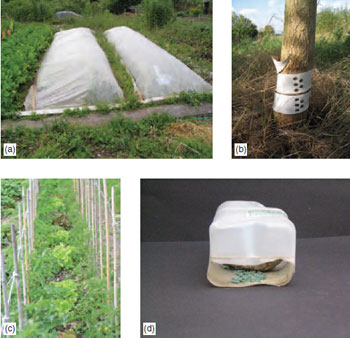Physical control
ContentBenefits: Physical controls are long-lasting and need little maintenance. Limitations: Some physical methods are expensive to set up. Warm water treatment This method is used for pests such as stem and bulb nematodes in narcissus bulbs. Immersion of bulbs for 2 hours at 44°C controls the pest without seriously affecting bulb tissues. Chrysanthemum stools and strawberry runners may be similarly treated, using temperature and time combinations favourable to each crop. Viruses (such as aspermy virus on chrysanthemum) are more difficult to control, since viruses are more intimately associated with the plant nuclei. Virus concentrations may be greatly reduced in meristems of stock plants grown at temperatures of 40°C for about a month. This has enabled the production of tissuecultured disease-free stock material of both edible and non-edible crops (see tissue culture). Flame throwers are used for the control of weeds when other methods, such as cultivation, hand-weeding or herbicidal control are not considered suitable. Partial soil sterilization Commercial greenhouse soils are commonly sterilized by high-pressure steam released to penetrate downwards into the soil, which is covered by heat resistant plastic sheeting (sheet steaming). The steam condenses on contact with soil particles, and moves deeper only when that layer of soil has reached steam temperature. Some active soil pests, such as symphilids, may move downwards ahead of the steam ‘front’. The temperatures required to kill most nematodes, insects, weed seeds and fungi are 45°C, 55°C, 55°C and 60°C respectively. Beneficial bacterial spores are not killed below 82°C, and therefore growers attempt to reach, but not exceed, this soil temperature. Most mycorrhizal fungi are unfortunately killed by this process. In this way, organisms difficult to sterilize, such as fungal sclerotia, Meloidogyne and Verticillium in root debris, may be killed. Sheet steaming is effective only to depths of about 15 cm, and its effect is reduced when soil aggregates are large and hard to penetrate, or when soils are wet and hard to heat up. When soil pests and diseases occur deep in the soil, heating pipes may be placed below the soil surface, as grids or spikes, to achieve a more thorough effect. The ‘ steam-plough ’ achieves a similar result, as it is winched along the greenhouse. If soil is to be used in growing composts it should be sterilized (see sterilizing equipment). The clear advantage of soil sterilization may occasionally be lost if a serious soil fungus (such as Pythium) is accidentally introduced into a crop where it may quickly spread in the absence of fungal competition. Barriers A physical barrier such as a fence sunk into the ground deters rabbits and deer. Fine screens placed over ventilation fans help prevent the entry of pests, such as fungus gnats, from outside a greenhouse or mushroom house. Pots placed on small stands in water-filled trays are freed from the visitations of red spider mite and adult vine weevils. Peach leaf curl is a difficult disease to control. A plastic sheet placed over the peach or almond over winter will greatly reduce both arrival of spores and the moisture needed for infection of the buds. Traps Pheremone traps containing a specific synthetic chemical similar to the attractant odour of a female moth are used in apple orchards to lure male codling and tortrix moths onto a sticky surface, thus enabling an accurate assessment of their numbers and therefore more effective control. Comparable traps are available against plum moth and pea moth.
Allotment owners sometimes use containers such as plastic milk bottles or jam jars sunk into the ground that when part-filled with beer, attract slugs. Between two rows of tomatoes, a ‘sacrificial’ row of lettuce can be grown to attract slugs (see Figure 16.2), which can then be controlled in a trap (see Figure 16.2). Deterrents Measures here warn off the pest in a chemical or physical way. Ultrasonic devices create high frequency sounds, unheard by humans, but offensive to animals such as rats and mice. The odour from onions inter-planted with carrots may deter the carrot fly from attacking its host crop. Marigolds planted in amongst crops deter whitefly and aphids. A spray repellent using an extract from a Yucca species is used to deter slug attack. |





